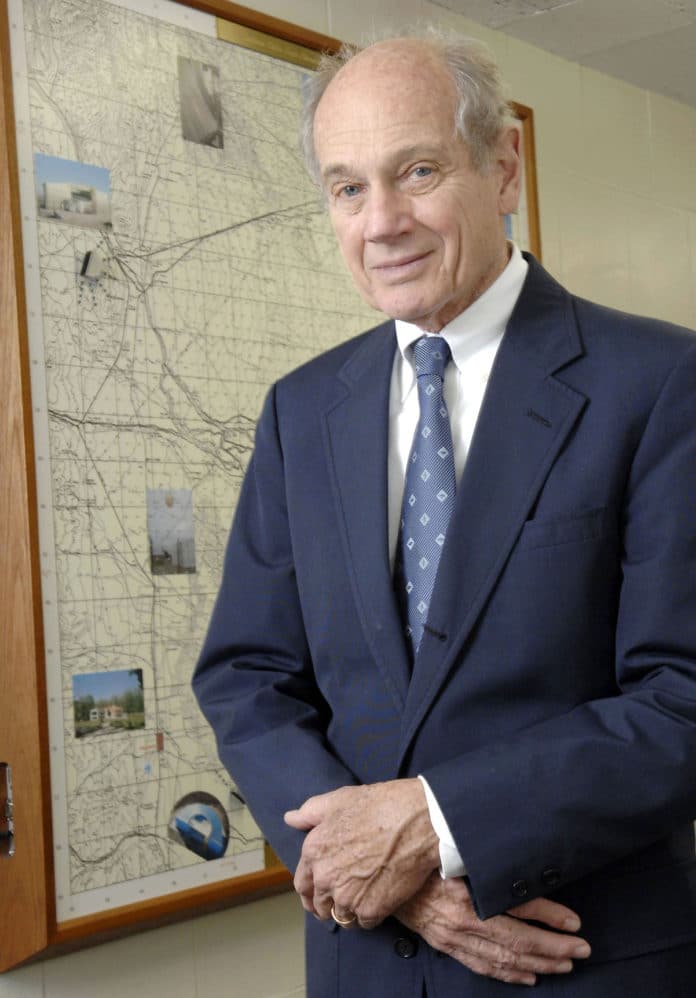James W. Cronin, who shared the Nobel prize in physics for discovering a startling breakdown in what was assumed to be the immutable symmetry of physical law, thereby helping to explain the behavior and evolution of the universe as a whole, died Aug. 25 in St. Paul, Minnesota. He was 84.
Cronin’s death was announced by the University of Chicago, where he was a professor emeritus of physics as well as of astronomy and astrophysics. No cause was reported.
Through the study of the decay of a single subatomic particle, Cronin and a colleague, Val Logsdon Fitch of Princeton University, made it possible for inferences to be drawn about the laws of nature on a scale as vast as the entire universe, in all its unfathomable immensity and multibillion-year duration. The two shared the 1980 Nobel.
Scientists had assumed a symmetry between the particles making up matter and what theory described as their oppositely charged counterparts. These counterparts formed what is known as antimatter.
In addition, it had been assumed that the laws of nature were, in the terms of science, “invariant under time reversal.” This meant essentially that physics would be the same whether time flowed forward or backward, a concept as intriguing as it is foreign to experience.
In demonstrating a breakdown of these symmetries, Cronin and Fitch prompted theories that explained the predominance in the universe of matter over antimatter. Such theories, he told an interviewer, explained our own existence and our very presence in nature. They explained, he said, “us.”
His experimental results were not what he thought they would be. Plotted by computer analysis of photographs from a new and much improved particle detector that he had built, the results showed a bump. It was a significant and unanticipated bump.
“We were surprised” he said, by the presence of “events we didn’t expect.”
He and Fitch, he said, “had no expectation we’d see anything other than … nothing.”
It is popular and entertaining to imagine scientists racing from their laboratory, filled with excitement of a finding that yanked a cornerstone from the edifice of physics.
It wasn’t like that, Cronin explained. The unexpected events – anomalous decays of neutral K mesons – made themselves known gradually. It was the sort of situation, he said in an interview, in which appreciation of the true meaning of an experiment “oozes into existence.”
The larger significance of the results was not lost on him. Nor was the seeming disparity between what he characterized as the somewhat unrefined nature of the experimental apparatus and techniques and the grandeur of the conclusions that it supported.
“It is amazing,” he said, that from imperfectly designed equipment, operated in a sometimes awkward manner, in a hot and dusty environment, could come what he described as “such profound consequences.”
In addition to being profound, the reasons for them were not well understood. In concluding his Nobel lecture in 1980, Cronin urged more work and voiced the hope “that at some epoch, perhaps distant, this cryptic message from nature will be deciphered.”
James Watson Cronin was born in Chicago on Sept. 29, 1931, while his father, James Farley Cronin, was pursuing graduate studies in classical languages at the University of Chicago.
He and his Nobel collaborator, Fitch, came from disparate backgrounds. Fitch was the son of a Nebraska rancher. Cronin’s father became a professor of Latin and Greek at Southern Methodist University in Dallas.
Cronin graduated in physics and mathematics from Southern Methodist in 1951. He then began graduate school at the University of Chicago, whose faculty included many of America’s physics luminaries, including Enrico Fermi and Edward Teller. His thesis, in experimental nuclear physics, was completed under the direction of Samuel K. Allison, who had played a key role in the Manhattan Project, the Allied effort in World War II to build a nuclear bomb.
Cronin also developed a fascination with particle physics because of another Chicago professor, future Nobel laureate Murray Gell-Mann. After receiving a doctorate in 1955, Cronin joined the Brookhaven National Laboratory on Long Island. There, he met Fitch, whom he credited with his move to Princeton in 1958 as an assistant professor of physics.
During what he described as a “glorious time for research,” he was deeply involved with development of the spark chamber. This particle detector was of vital importance in the Nobel work.
After his groundbreaking discovery, which was made in 1963, and published the next year, he worked for a year at the Saclay Nuclear Research Center in France. Having risen to a full professorship, he joined the faculty at the University of Chicago in 1971 because the school had nearly completed construction of one of the most powerful particle accelerators in the world.
After his prize-winning work, he eventually turned to research in cosmic rays. One reason, he told an interviewer, was he preferred to have greater responsibility for his own work and control over it. Early in his career, individuals, or teams of three or four could push the frontiers of particle physics.
In time, he noted, a research paper, based on findings from experiments on a gåiant particle accelerator, might credit 1,000 authors.
His first wife, Annette Martin, died in 2005. The next year, he married Carol McDonald, who survives along with two children from his first marriage, Emily Grothe and Daniel Cronin, and six grandchildren, according to the University of Chicago. Another daughter, Cathryn Cranston, publisher of the Columbia Journalism Review, died in 2011 of leukemia.
In his Nobel biographical statement, he emphasized the importance of his family to his career. “On even the worst days, when nothing was working at the lab, I knew that at home I would find warmth, peace, companionship, and encouragement. As a consequence, the next day would surely be better.”






